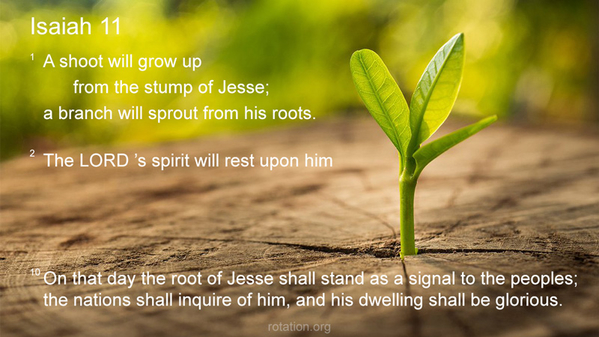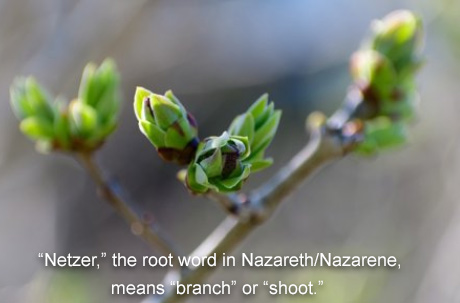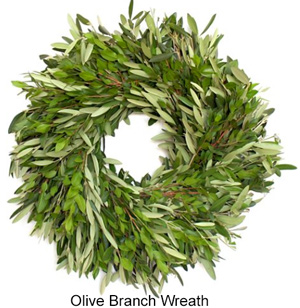A "Biblical" Advent Wreath
One inspired by scripture, not tradition
Suggestions for a wreath project or children's sermon
using the biblical imagery of branches and twigs from Isaiah 11 and Jeremiah 33.
I find it odd that the Church embraces the non-biblical symbol of the "evergreen" while largely ignoring the biblical imagery the sprouting branch taught by BOTH Isaiah 11 and Jeremiah 33 as the metaphor for the promise and coming of the Messiah.
From a teacher and pastor's perspective, I'd much rather teach and promote the meaning of biblical images than secular ones. Doing so grounds our kids in scripture, and as my suggestions below will show, it is pretty easy to do.
“‘In those days and at that time I will make
a righteous Branch sprout from David’s line" (Jer 33:15)
A shoot will grow up from the stump* of Jesse;
a branch will sprout from his roots." (Isaiah 11:1)
[*Re: Stump. The Hebrew word is "geza" -- which can mean "stem," "branch," "root," or perhaps even "stump." "Stump" was popularized by the RSV and NIV, but it's not the only possibility. You can check out the Hebrew yourself.]
Personally, I love the nostalgia and smell of evergreen Christmas trees and wreaths, but they were originally a "pagan" symbol whose origins are lost in the mist of history and metaphorically speak very little about the hope for a Messiah. Whereas, the Bible provides us with "sprouting branch" imagery that is visually similar to evergreens, are easy to work with from a decoration or teaching perspective, AND is MUCH more meaningful in terms of the teaching about Christ's birth and its connection to the Old Testament story.
How Did We Get So "Evergreen"?
Evergreen boughs were used in ancient cultures at funerals to symbolize the hope of the afterlife. The Romans gave and displayed evergreen boughs at the Winter Solstice to symbolize the hope that the gods would give humanity another year. The Christian Church co-opted and reinterpreted the evergreen symbol to signify resurrection, and somewhere along the line evergreens started showing up in Christmas celebrations (which not so coincidentally were also celebrated the week before the new year). The first Christmas tree is said to have appeared sometime in the 15th Century when it was decorated and lit on fire (both the tree and fire likely being the remnant of some pre-Christian winter celebration). The "lights" on a Xmas tree became the symbol we most associate with scripture -- the light coming into the world. Though few still put lit candles on real trees anymore (for obvious safety reasons), the practice of lighting evergreens on fire has come down to us in the lighting of Advent candles tucked into an evergreen wreath to mark the approach of Christmas.
The New Testament picks up on the "branches" metaphor
The "vine and branches" metaphor was used by Jesus in John 15 when he says, "I am the vine, you are the branches, cut off from me you can do nothing." The vine he likely was referring to was the woody grapevine.
Paul in Romans 11 uses the image of an olive tree and its branches when he says "some of the branches have been broken off, and you, though a wild olive shoot, have been grafted in among the others and now share in the nourishing sap from the olive root."
It has also been long noted that “Nazareth” and “Nazarene” have the Hebrew root “netzer” which means “branch” or “shoot.”
All of which is to say that we have biblical images we could be using in our Advent decorations, instead of only pagan ones. These biblical images and props could also make a nice children’s sermon or Advent craft project And unlike “evergreen,” the image of branches and shoots has life application as well! How are you connected to Christ and showing his fruit?
Below are some images and comments about the various types of "branches" you could employ. Keep in mind that the "stump" or "branch" referred to by Isaiah and Jeremiah could be any one of a NUMBER of valuable tree species, including oak, terebinth, olive, sycamore, cinnamon, chamomille, gum, cedar.
Fresh cut olive branches can be ordered online or through your florist. They are not expensive.


Grapevine can be ordered online or found at local craft houses. They can be shaped into wreaths. Plastic flower "sprigs" and "buds" can be attached with green floral wire to symbolize Isaiah's "sprouting branch." Grapevine already shaped into small wreaths and heart shapes can be purchased in bulk for less than $1 each online.

Budding branches can be purchased from florists in Advent and would make a great object lesson. They can be kept in water, taken home, or woven into a wreath.

The "shoot" that God brings forth from the root of Jesse is metaphorically related to all the passages about "bearing good fruit" too.
And why not a "stump" on your chancel this Advent?
Candles could be set on it and lit to mark the coming of Christmas. It could have a single flower in the middle representing the "righteous branch" or "sprout" that the prophets describe. Lots of possibilities.

And yes, the "stump of Jesse" is the origin of the venerable "Jesse Tree" project in Sunday School. There is an old Christmas tradition of using a Jesse Tree, like an Advent calendar. Children hang ornaments on it -- each ornament representing a part of the story from Creation to the Birth of Christ. Only I wonder why it's a Jesse "Tree" and not a Jesse "Stump"?


And then there is 1 Peter 2:24's unique description of the cross as a tree!
He himself bore our sins in his body on the tree, that we might die to sin and live to righteousness. By his wounds you have been healed. (ESV)
Interestingly, some modern translations change "tree" to "cross" ...which is really too bad because the exact word that 1 Peter uses is NOT "cross" but "xylon" which can mean "wood/beam/log or tree." Whereas the word used in the Gospels for "cross" is "stauros." So you might say that forgiveness did indeed SPROUT from a stick. (God loves metaphors.)

















